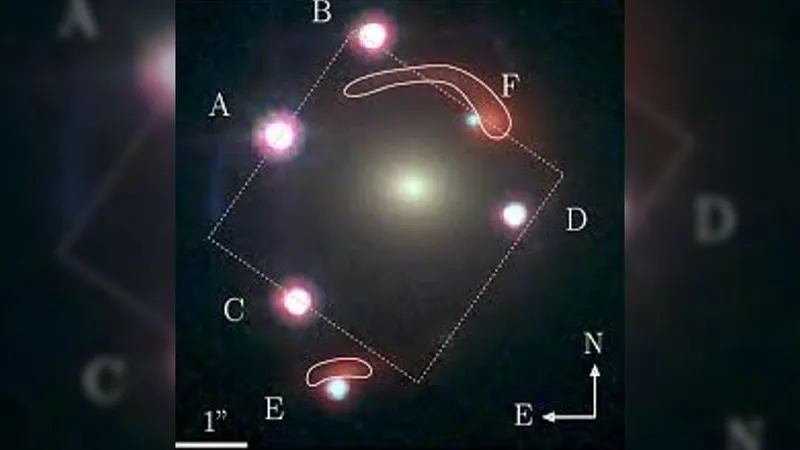
The James Webb Telescope Makes History: Unveiling the First 'Einstein Zig-Zag' That Could Revolutionize Cosmology!
2024-11-19
Author: Sarah
The Einstein Zig-Zag Discovery
For the first time ever, the James Webb Space Telescope (JWST) has unveiled a remarkable phenomenon known as the "Einstein zig-zag," a phenomenon theorized by scientists that occurs when light traverses warped regions of space-time. This groundbreaking discovery was made among a set of six identical images of a luminous quasar, shedding new light on questions that have puzzled cosmologists.
Background on J1721+8842
Back in 2018, astronomers detected four identical bright points in the cosmos, collectively named J1721+8842, located billions of light-years from Earth. Initially, these lights were thought to be mirror images of a single quasar—an incredibly bright galactic core fueled by a supermassive black hole—created through an intriguing natural occurrence called gravitational lensing.
Understanding Gravitational Lensing
Gravitational lensing occurs when massive objects, such as galaxies, bend the light coming from distant celestial bodies, creating multiple images or stretched halos known as Einstein rings, named after Albert Einstein, who predicted this occurrence with his general relativity theory in 1915.
New Findings in 2022
In a surprising twist in 2022, researchers found two additional fainter points of light accompanying the original quartet, along with an elusive red Einstein ring. This led scientists to hypothesize the presence of multiple quasars rather than just a single one. However, the most recent findings suggest otherwise.
Groundbreaking Research from JWST
In a groundbreaking study uploaded to the preprint server arXiv on November 8, researchers reexamined J1721+8842 using new data from the JWST and confirmed that all six points of light originate from a single quasar. They revealed that some of these light sources have been gravitationally lensed around an additional massive object, which also causes the faint Einstein ring detected in images.
Monitoring Light Curves
The researchers monitored the light curves of these bright spots over two years and found a slight delay in the travel time of the two faintest images. This observation suggests that the light from these duplicates took a longer route, explaining the zig-zagging effect as the light passed around two gravitational lenses, thus earning its name.
Implications for Cosmology
Why does this matter? Gravitationally lensed phenomena, such as Einstein rings, are invaluable tools for astronomers and cosmologists, providing insights into the mass of the galaxies responsible for the lensing. This knowledge is crucial in uncovering secrets about dark matter and dark energy—two mysterious components driving the expansion of the universe.
The JWST's Role
The JWST has excelled at discovering these lensed objects in previously unreachable corners of the universe. However, it also highlights unresolved discrepancies in our understanding of cosmic expansion, particularly the Hubble tension—the puzzling observation that different regions of the universe appear to be expanding at varying rates.
Potential Solutions to Hubble Tension
Encouragingly, the newly identified Einstein zig-zag may offer a solution to this tension. Its unique light-bending configuration will enable astronomers to measure the Hubble constant—the rate of cosmic expansion—and the amount of dark energy more precisely than ever before, potentially unlocking vital insights into the workings of our universe.
Next Steps for Research
The scientific community eagerly awaits peer review of this significant study, hoping that it will pave the way for a deeper understanding of the cosmos and address some of the fundamental challenges currently facing modern physics. Stay tuned, as this discovery may change everything we thought we knew about the universe!


 Brasil (PT)
Brasil (PT)
 Canada (EN)
Canada (EN)
 Chile (ES)
Chile (ES)
 España (ES)
España (ES)
 France (FR)
France (FR)
 Hong Kong (EN)
Hong Kong (EN)
 Italia (IT)
Italia (IT)
 日本 (JA)
日本 (JA)
 Magyarország (HU)
Magyarország (HU)
 Norge (NO)
Norge (NO)
 Polska (PL)
Polska (PL)
 Schweiz (DE)
Schweiz (DE)
 Singapore (EN)
Singapore (EN)
 Sverige (SV)
Sverige (SV)
 Suomi (FI)
Suomi (FI)
 Türkiye (TR)
Türkiye (TR)